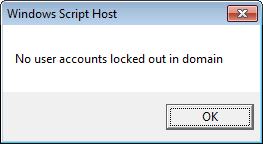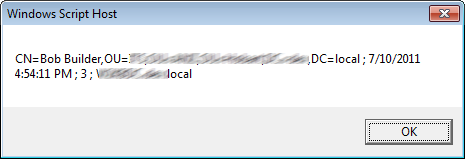The following VBS Script will check your Active Directory environment for user accounts which are currently locked out.
This could be used to assist with diagnosing accounts which are repetitively being locked.
Output:
If there are no accounts locked out it will return “No user accounts locked out in domain.”
If there are accounts locked out it will return a prompt for each locked out account. It will also indicate the time and date when the account was locked out.
VBS Script:
' Hilltop Lab web site - http://www.rlmueller.net
Option Explicit
Dim objRootDSE, strConfig, adoConnection, adoCommand, strQuery
Dim adoRecordset, objDC
Dim strDNSDomain, objShell, lngBiasKey, lngBias, k, arrstrDCs()
Dim strDN, dtmDate, objDate, strUser, strNTName
Dim objList1, objList2, objList3, j, intBadCount
Dim strBase, strFilter, strAttributes, objWinNTUser
Dim objTrans, strNetBIOSDomain, objDomain, arrstrNTNames()
Dim lngHigh, lngLow
‘ Constants for the NameTranslate object.
Const ADS_NAME_INITTYPE_GC = 3
Const ADS_NAME_TYPE_NT4 = 3
Const ADS_NAME_TYPE_1779 = 1
‘ Determine DNS domain name.
Set objRootDSE = GetObject(“LDAP://RootDSE”)
strDNSDomain = objRootDSE.Get(“defaultNamingContext”)
‘ Use the NameTranslate object to convert the DNS domain name
‘ to the NetBIOS domain name.
Set objTrans = CreateObject(“NameTranslate”)
objTrans.Init ADS_NAME_INITTYPE_GC, “”
objTrans.Set ADS_NAME_TYPE_1779, strDNSDomain
strNetBIOSDomain = objTrans.Get(ADS_NAME_TYPE_NT4)
‘ Remove trailing backslash.
strNetBIOSDomain = Left(strNetBIOSDomain, Len(strNetBIOSDomain) – 1)
‘ Find locked out user accounts in domain
‘ create array of sAMAccountName’s
Set objDomain = GetObject(“WinNT://” & strNetBIOSDomain)
objDomain.Filter = Array(“user”)
k = 0
For Each objWinNTUser In objDomain
If (objWinNTUser.IsAccountLocked = True) Then
ReDim Preserve arrstrNTNames(k)
arrstrNTNames(k) = objWinNTUser.name
k = k + 1
End If
Next
If (k = 0) Then
Wscript.Echo “No user accounts locked out in domain”
Wscript.Quit
End If
‘ Use dictionary objects to track latest badPasswordTime,
‘ badPwdCount, and Domain Controller for each locked out user.
Set objList1 = CreateObject(“Scripting.Dictionary”)
objList1.CompareMode = vbTextCompare
Set objList2 = CreateObject(“Scripting.Dictionary”)
objList2.CompareMode = vbTextCompare
Set objList3 = CreateObject(“Scripting.Dictionary”)
objList3.CompareMode = vbTextCompare
‘ Obtain local Time Zone bias from machine registry.
‘ This bias changes with Daylight Savings Time.
Set objShell = CreateObject(“Wscript.Shell”)
lngBiasKey = objShell.RegRead(“HKLM\System\CurrentControlSet\Control\” _
& “TimeZoneInformation\ActiveTimeBias”)
If (UCase(TypeName(lngBiasKey)) = “LONG”) Then
lngBias = lngBiasKey
ElseIf (UCase(TypeName(lngBiasKey)) = “VARIANT()”) Then
lngBias = 0
For k = 0 To UBound(lngBiasKey)
lngBias = lngBias + (lngBiasKey(k) * 256^k)
Next
End If
‘ Determine configuration context.
strConfig = objRootDSE.Get(“configurationNamingContext”)
‘ Use ADO to search Active Directory for ObjectClass nTDSDSA.
‘ This will identify all Domain Controllers.
Set adoCommand = CreateObject(“ADODB.Command”)
Set adoConnection = CreateObject(“ADODB.Connection”)
adoConnection.Provider = “ADsDSOObject”
adoConnection.Open = “Active Directory Provider”
adoCommand.ActiveConnection = adoConnection
strBase = “<LDAP://” & strConfig & “>”
strFilter = “(objectClass=nTDSDSA)”
strAttributes = “AdsPath”
strQuery = strBase & “;” & strFilter & “;” & strAttributes & “;subtree”
adoCommand.CommandText = strQuery
adoCommand.Properties(“Page Size”) = 100
adoCommand.Properties(“Timeout”) = 60
adoCommand.Properties(“Cache Results”) = False
Set adoRecordset = adoCommand.Execute
‘ Enumerate parent objects of class nTDSDSA. Save Domain Controller
‘ DNS host names in dynamic array arrstrDCs.
k = 0
Do Until adoRecordset.EOF
Set objDC = _
GetObject(GetObject(adoRecordset.Fields(“AdsPath”).Value).Parent)
ReDim Preserve arrstrDCs(k)
arrstrDCs(k) = objDC.DNSHostName
k = k + 1
adoRecordset.MoveNext
Loop
adoRecordset.Close
‘ Use ADO to retrieve all user objects from each Domain Controller.
strFilter = “(&(objectCategory=person)(objectClass=user))”
strAttributes = “distinguishedName,sAMAccountName,” _
& “badPasswordTime,badPwdCount”
For k = 0 To Ubound(arrstrDCs)
strBase = “<LDAP://” & arrstrDCs(k) & “/” & strDNSDomain & “>”
strQuery = strBase & “;” & strFilter & “;” & strAttributes _
& “;subtree”
adoCommand.CommandText = strQuery
On Error Resume Next
Set adoRecordset = adoCommand.Execute
If (Err.Number <> 0) Then
On Error GoTo 0
Wscript.Echo “Domain Controller not available: ” & arrstrDCs(k)
Else
On Error GoTo 0
Do Until adoRecordset.EOF
strNTName = adoRecordset.Fields(“sAMAccountName”).Value
‘ Check each user to see if in array of locked out accounts.
For j = 0 To UBound(arrstrNTNames)
If (UCase(strNTName) = UCase(arrstrNTNames(j))) Then
‘ User locked out, retrieve badPasswordTime.
strDN = adoRecordset.Fields(“distinguishedName”).Value
intBadCount = adoRecordset.Fields(“badPwdCount”).Value
On Error Resume Next
Set objDate = adoRecordset.Fields(“badPasswordTime”).Value
If (Err.Number <> 0) Then
On Error GoTo 0
dtmDate = #1/1/1601#
Else
On Error GoTo 0
lngHigh = objDate.HighPart
lngLow = objDate.LowPart
If (lngLow < 0) Then
lngHigh = lngHigh + 1
End If
If (lngHigh = 0) And (lngLow = 0) Then
dtmDate = #1/1/1601#
Else
dtmDate = #1/1/1601# + (((lngHigh * (2 ^ 32)) _
+ lngLow)/600000000 – lngBias)/1440
End If
End If
If (objList1.Exists(strDN) = True) Then
If (dtmDate > objList1.Item(strDN)) Then
‘ Later badBadPasswordTime found, save info from this DC.
objList1.Item(strDN) = dtmDate
objList2.Item(strDN) = intBadCount
objList3.Item(strDN) = arrstrDCs(k)
End If
Else
‘ First time user found, save info from this DC.
objList1.Add strDN, dtmDate
objList2.Add strDN, intBadCount
objList3.Add strDN, arrstrDCs(k)
End If
End If
Next
adoRecordset.MoveNext
Loop
adoRecordset.Close
End If
Next
‘ Output information on each locked out user.
For Each strUser In objList1.Keys
Wscript.Echo strUser & ” ; ” & objList1.Item(strUser) & ” ; ” _
& objList2.Item(strUser) & ” ; ” & objList3.Item(strUser)
Next
‘ Clean up.
adoConnection.Close

